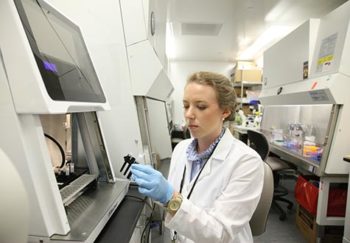 Kristine Olson, PhD, contributed this post. She is an instructor of research with UVA Cancer Center and works closely with Thomas P. Loughran, Jr., MD, who discovered LGL leukemia.
Kristine Olson, PhD, contributed this post. She is an instructor of research with UVA Cancer Center and works closely with Thomas P. Loughran, Jr., MD, who discovered LGL leukemia.
Disclaimer: Please discuss your specific situation with your healthcare provider. This article will discuss general guidelines.
If you would like some background information on LGL leukemia, here are some introductory resources:
- The first LGL leukemia blog story
- Tutorials, under Educational Content
- A review article by Thomas Loughran, MD, from the journal Blood, under Research & Treatment Resources
LGL Leukemia Patients Have a Wide Range of Symptoms
If you’ve been diagnosed with LGL leukemia, your symptoms may fall within a wide range, from asymptomatic (no symptoms) to symptoms such as severe fatigue. If you also have rheumatoid arthritis, you may experience joint pain. While some patients lead fairly typical lives, with minimal fatigue, others seem to have chronic severe fatigue that prevents them from working or doing activities that they enjoy. It may be difficult to work and keep up a household if you feel tired all the time. How do you deal with symptoms and still lead a fulfilling life?
What Causes Fatigue?
Patients with LGL leukemia may have fatigue to varying degrees. Sometimes this fatigue can be explained by a low level of red blood cells. A term to describe a low amount of red blood cells is anemia. Red blood cells bind oxygen in the lungs and then deliver it through our bloodstream to all parts of our bodies. Oxygen demands in different parts of our bodies can vary. For example, we need a baseline level of oxygen to carry out metabolism in all our cells, but skeletal muscle requires a greater supply of oxygen during exercise.
There are a number of causes of anemia, which will be explored by your physician through various laboratory tests and clinical observations. These would include common causes of anemia not related to LGL leukemia such as iron, B-12, or folic acid deficiency. You would likely have a complete blood count laboratory test, and parameters such as low hemoglobin or hematocrit will let your physician determine if you have anemia.
Hemoglobin reference ranges differ by age and gender, but generally a level of 12 g/dL for women and 14 g/dL for men is considered a normal minimum. This hemoglobin value is read as 12 grams per deciliter (a deciliter is one-tenth of one liter). Hematocrit is a percent value that tells you how much of your blood volume is red blood cells. This reference range also differs by age and gender, but would be a minimum of 35% for women and 40% for men. If your hematocrit percent is below those values, then the body is not able to efficiently deliver oxygen to all tissues in the body.
If common causes of anemia are not present, then it is likely that LGL leukemia is the cause of the anemia. One form of anemia occurring in LGL leukemia is a hemolytic anemia, in which case antibodies are made to red blood cells which cause their early destruction. Anemia in LGL leukemia can also be caused by the LGL attacking the cells that make the red blood cells in the marrow, causing a hypoproliferative anemia. There are other diseases connected to LGL leukemia that can cause anemia such as pure red cell aplasia or if all blood cells are low, aplastic anemia.
In these cases, the bone marrow is making inadequate or no amount of red blood cells. Consequently, patients may need regular blood transfusions in order to replenish their red blood cell numbers. Treatment for anemia is always indicated if patients need transfusions to keep their hemoglobin/hematocrit above the danger zone of 8 g/dL. Patients with higher amounts of hemoglobin would also be considered for treatment if their symptoms of anemia, such as fatigue or shortness of breath, are very severe. If patients have these secondary blood disorders and require frequent transfusions, Loughran usually initiates immunosuppressant treatment.
Unfortunately, fatigue is not always explained by such reasons, as some patients have normal red blood cell counts but still experience extreme fatigue. In Loughran’s experience, this has been anecdotally correlated to low neutrophil counts, which is not an expected source of fatigue. This is a potential area of new research interest for the lab. One theory is that leukemic LGL cells produce excessive amounts of inflammation molecules, such as protein cytokines. These cytokines are a normal part of the immune response, but when produced out of control, they can cause damage.
How Can I Cope With My Diagnosis and Symptoms?
If you have severe fatigue and you have a difficult time leading a typical life, you may wish to speak with your physician about what can be done to improve your life. Your physician may decide that further testing is warranted or to put you on immunosuppressive treatment to see if your symptoms get better.
If your physician thinks your other blood count parameters do not warrant starting treatment, then he/she may suggest lifestyle changes. Since everyone is different, you may need to try a few things before you see an improvement in your energy level.

